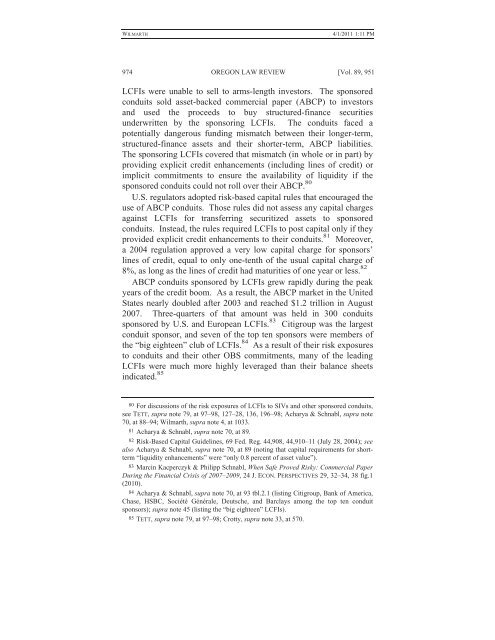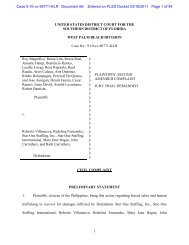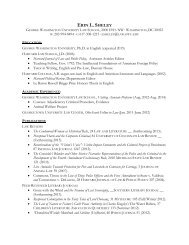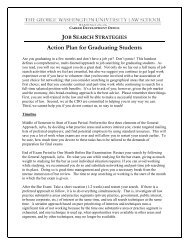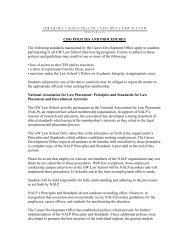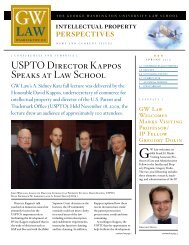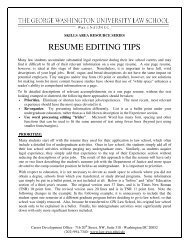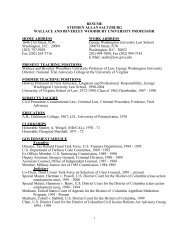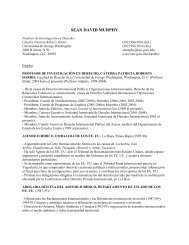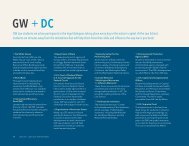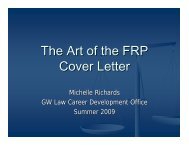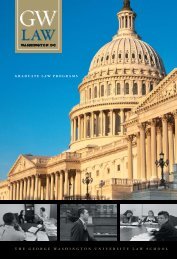CLE Materials for Panel #1 - George Washington University Law ...
CLE Materials for Panel #1 - George Washington University Law ...
CLE Materials for Panel #1 - George Washington University Law ...
Create successful ePaper yourself
Turn your PDF publications into a flip-book with our unique Google optimized e-Paper software.
WILMARTH<br />
4/1/2011 1:11 PM<br />
974 OREGON LAW REVIEW [Vol. 89, 951<br />
LCFIs were unable to sell to arms-length investors. The sponsored<br />
conduits sold asset-backed commercial paper (ABCP) to investors<br />
and used the proceeds to buy structured-finance securities<br />
underwritten by the sponsoring LCFIs. The conduits faced a<br />
potentially dangerous funding mismatch between their longer-term,<br />
structured-finance assets and their shorter-term, ABCP liabilities.<br />
The sponsoring LCFIs covered that mismatch (in whole or in part) by<br />
providing explicit credit enhancements (including lines of credit) or<br />
implicit commitments to ensure the availability of liquidity if the<br />
sponsored conduits could not roll over their ABCP. 80<br />
U.S. regulators adopted risk-based capital rules that encouraged the<br />
use of ABCP conduits. Those rules did not assess any capital charges<br />
against LCFIs <strong>for</strong> transferring securitized assets to sponsored<br />
conduits. Instead, the rules required LCFIs to post capital only if they<br />
provided explicit credit enhancements to their conduits. 81 Moreover,<br />
a 2004 regulation approved a very low capital charge <strong>for</strong> sponsors’<br />
lines of credit, equal to only one-tenth of the usual capital charge of<br />
8%, as long as the lines of credit had maturities of one year or less. 82<br />
ABCP conduits sponsored by LCFIs grew rapidly during the peak<br />
years of the credit boom. As a result, the ABCP market in the United<br />
States nearly doubled after 2003 and reached $1.2 trillion in August<br />
2007. Three-quarters of that amount was held in 300 conduits<br />
sponsored by U.S. and European LCFIs. 83 Citigroup was the largest<br />
conduit sponsor, and seven of the top ten sponsors were members of<br />
the “big eighteen” club of LCFIs. 84 As a result of their risk exposures<br />
to conduits and their other OBS commitments, many of the leading<br />
LCFIs were much more highly leveraged than their balance sheets<br />
indicated. 85<br />
80 For discussions of the risk exposures of LCFIs to SIVs and other sponsored conduits,<br />
see TETT, supra note 79, at 97–98, 127–28, 136, 196–98; Acharya & Schnabl, supra note<br />
70, at 88–94; Wilmarth, supra note 4, at 1033.<br />
81 Acharya & Schnabl, supra note 70, at 89.<br />
82 Risk-Based Capital Guidelines, 69 Fed. Reg. 44,908, 44,910–11 (July 28, 2004); see<br />
also Acharya & Schnabl, supra note 70, at 89 (noting that capital requirements <strong>for</strong> shortterm<br />
“liquidity enhancements” were “only 0.8 percent of asset value”).<br />
83 Marcin Kacperczyk & Philipp Schnabl, When Safe Proved Risky: Commercial Paper<br />
During the Financial Crisis of 2007–2009, 24 J. ECON.PERSPECTIVES 29, 32–34, 38 fig.1<br />
(2010).<br />
84 Acharya & Schnabl, supra note 70, at 93 tbl.2.1 (listing Citigroup, Bank of America,<br />
Chase, HSBC, Société Générale, Deutsche, and Barclays among the top ten conduit<br />
sponsors); supra note 45 (listing the “big eighteen” LCFIs).<br />
85 TETT, supra note 79, at 97–98; Crotty, supra note 33, at 570.


